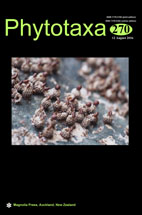Abstract
The current generally accepted concept of Russula maculata defines the species by yellow-brownish spots on the basidiomata, an acrid taste, a yellow spore print and a red pileus. This concept was tested using collections originating from various geographical areas mainly in Europe. Analyses of the ITS region suggested that there were three species within this broad concept. One of them, R. maculata, was identified based on the sequence from the epitype. Two other species, R. nympharum and R. sp., are described here as newly identified species. The European species R. maculata and R. nympharum grow in deciduous forests, are similar in their field aspect and are distinctly different in micro-morphological characteristics of spores, pleurocystidia and pileipellis. An Asian species, R. sp., is associated with pine and has smaller basidiomata and spores. These three species form the R. maculata complex and represent the sister clade to the R. globispora complex. This clade consists of species also characterized by a yellow-brownish context discolouration but with a different type of spore ornamentation. All of the other tested species had an acrid taste and yellow spore print but did not have a conspicuous yellow-brownish context discolouration and were placed in various unrelated clades.

